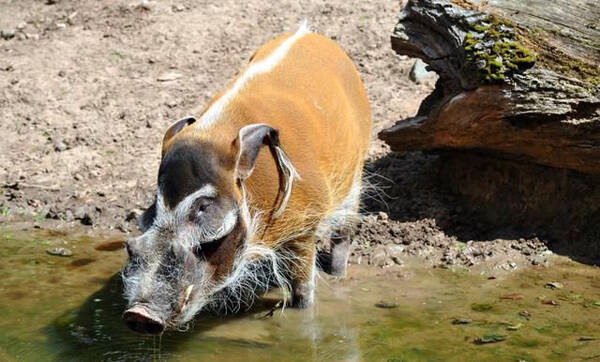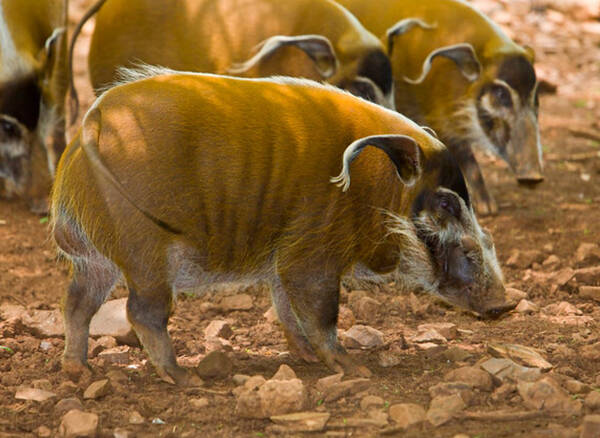Potamochoerus porcus
IUCN
LCBasic Information
Scientific classification
- name:Potamochoerus porcus
- Scientific Name:Potamochoerus porcus,Red River Hog,West African bush pig, tufted pig, red river hog
- Outline:Ungulata
- Family:Artiodactyla Suidae A.peccary
Vital signs
- length:100-150cm
- Weight:50-130kg
- lifetime:10-15years
Feature
The smallest and most colorful of all African pigs
Distribution and Habitat
Origin: Benin, Cameroon, Central African Republic, Congo, Democratic Republic of Congo, Côte d'Ivoire, Equatorial Guinea, Gabon, Ghana, Guinea, Guinea-Bissau, Liberia, Mali, Nigeria, Senegal, Sierra Leone, South Sudan, Togo and Uganda.
Presence uncertain: Sudan.
It mainly inhabits coastal forests and swampy edges of primary rainforests, some areas with high vegetation cover. In the transition zone, it often occurs in dry forests, savanna woodlands and cultivated land. The species is highly adaptable and can benefit from the regeneration of logged forest areas by providing a wider variety of food sources and reducing its natural predators. The species population density ranges from 1-6 individuals per square kilometer, but great variation has been recorded, for example, up to 18.4 individuals per square kilometer have been recorded in the transition zone between Lopé National Park in Gabon - savanna ecological transition zone.
Appearance
The Red River Boar has a head-body length of 100-150 cm and a tail length of 0.3-0.4 m. With a shoulder height of 50-90 cm and a weight of 50-130 kg, it is the smallest and most colorful of all African pigs. The body color varies greatly, mainly bright russet to orange. There is a narrow white dorsal line between the head and tail, which stands up when the animal is excited. The species has fur ranging from red to brown or black in the eastern and southern parts of its distribution. In some eastern and southern areas, their fur becomes darker as they age. The fur is short, except for longer brushes on the jaws and flanks. Many Red River Boars have a white mask, and the head contrasts sharply with bold markings such as the mask: a gray muzzle, white "eyebrows" around the eyes, white cheeks and whiskers, and black marks on the nose, chin, ears, and forehead. The face has sideburns, and the sideburns are gray. The ear pinnae have a prominent tuft of white hair, and the Red River
Details
Red River Hog (scientific name: Potamochoerus porcus) is also known as Red River Hog, and has no subspecies.

Red River Hog is a social animal. Most live in groups of 3-6, and there are groups of up to 11. Large groups of more than 100 animals have been recorded. In most cases, there is a dominant adult male boar in these small family groups. They mark their paths by scraping tree trunks with their canines (tusks) and using foot, neck, and preorbital glands. They threaten other animals that enter their territory with their masks and loud noises. In fights, the species simultaneously presses foreheads, butts heads, lunges with their snouts, and whips each other with their tails.
Red River Boars are most active in the evening and at night, resting during the day in caves deep in dense jungle. They are capable of searching for food over long distances and prefer to rest in shallow, swampy depressions. In some areas, the narrowness and linearity of the species' home range (riparian forests in savanna habitats) may force frequent and extensive movements. Boars roam in relatively large home ranges, sometimes exceeding 4 km between resting and feeding areas. The average daily distance is 3-6 km, depending on food availability and the number of subadults in the group. There are groups of 6-20, with females, piglets, sub-adults and young wild boars and a large male pig participating. As with other wild boars, older sub-adult males will be bullied by their fathers if they come too close to feeding or watering. On the move, wild boars communicate through soft grunts to maintain group cohesion, and they use a variety of vocalizations suitable for various environments. Within the shared home range, males express their presence and status through frequent rubbing and spreading of trees.
The entire Red River wild boar group flees when alarmed or frightened. If striped piglets are present, they will curl up and stagnate, while adults are at risk. When they are cornered or injured, they can show considerable courage and actively attack predators, including humans. Red River wild boars are very good swimmers and are often seen crossing large rivers. Their main natural enemies are humans and leopards, but lions, spotted hyenas and pythons are also local. The biomass of Red River wild boar preyed by leopards accounts for 20% of the total.

Red River wild boar is an omnivore with a clear preference for roots and tubers. They also feed on grasses, aquatic plants, bulbs, fruits, nuts, grasses, crops and fungi; they also eat a variety of small animals, including insects, bird eggs, snails, reptiles, carrion and domestic animals such as piglets, goats and sheep. They dig roots in the soil, such as potatoes and bulbs, and can also swim and forage for aquatic plants. They use their trunks to dig in the ground and can cause serious damage to crops. The species also uses the noises and calls of monkeys and fruit-eating birds to test potential fruit food. The seasonal aggregations of the Red River Peccaries that feed on fruit can be as large as temporary groups of more than 60 individuals. In the Makokou region of Gabon, these groups are very noisy while eating the hard nut shells of Aconitum and Wild Mango, which attracts the attention of predators and secondary predators. They sometimes follow the Guinea Birds, looking for food on the ground that they peck or turn over. They will follow chimpanzees in search of fallen fruit. They are particularly fond of the seeds of the oak tree "Balanites wilsoniana". The seasonal large availability of preferred foods and their high abundance of fruits explain the semi-nomadic movement cycle of the Red River Peccaries.
The breeding season for the Red River Boar lasts from September to April and peaks during the rainy season from November to February. During this period, the species mates using a variety of ritualized postures, during which the male releases glandular secretions. The gestation period is 120-127 days. Parturition occurs in February-March in Nigeria and December-January in Gabon, but females can give birth twice a year in captivity. The females build grass nests, 3 meters wide and 1 meter deep. Each litter has 1-4 piglets, rarely 6. The piglets weigh between 650-900 grams and are born in a sheltered hollow covered with a thick mattress of grass and leaves. After staying with their mother for 10-15 days, they join the rest of the group. The weaning period is 2-4 months. Monogamous, both the mother and the main male pig of the small family provide care and protection for the piglets. Females give birth to 1 litter per year. Sexual maturity is reached at 18-24 months. Lifespan 10-15 years.
The Red River Boar is a potential food source for humans. It has been suggested that the Red River Boar could be domesticated. As the species' main predator, the leopard, has declined, the pig population has been on the rise. This is detrimental to humans in many ways, as large herds of Red River Boar can wreak havoc on crops. They also eat livestock and can be carriers of diseases such as African swine fever that affect domestic animals. African swine fever is carried by ticks, and while it does not harm the Red River Boar, the Red River Boar can transmit the disease to domestic pigs, where it is fatal. The main threat to the species is the increasing pressure to find a commercial bushmeat trade and to sustain livelihoods. Along with its rivals, it is one of the most sought after and hunted species in the Congo Basin, accounting for 40% of bushmeat sold in Gabon. In the Congo Basin, high demand for bushmeat and the spread of gun hunting are factors that could easily threaten the survival of this species. Experiments in captivity have shown its sensitivity to stress during capture, with low survival rates for young (11-57%).
Protect wildlife and eliminate bushmeat.
Maintaining ecological balance is everyone's responsibility!








